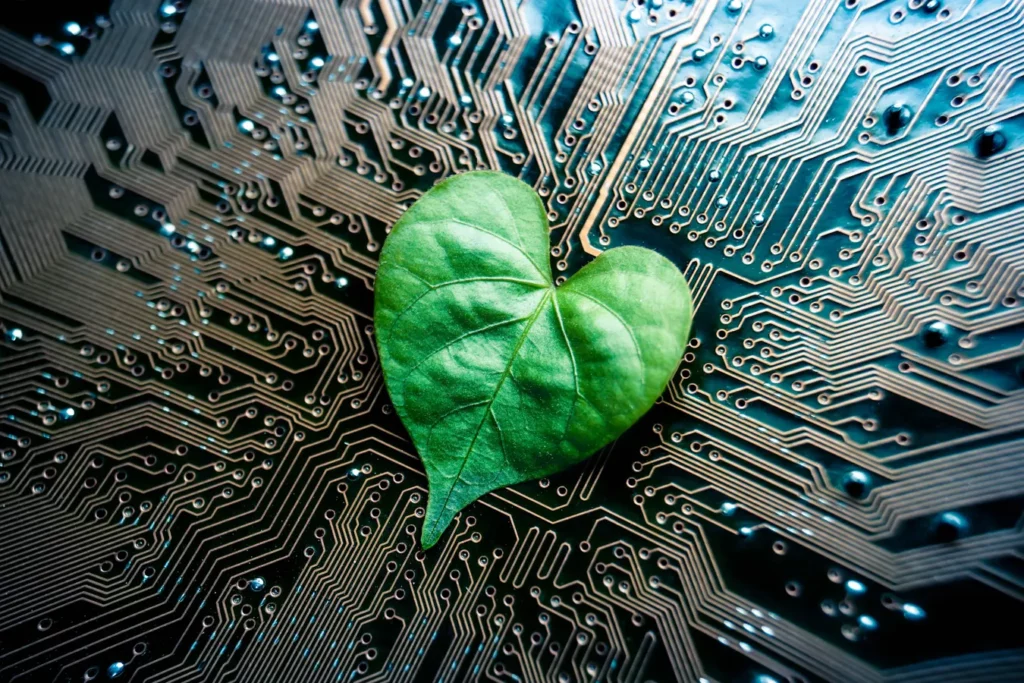In the fast-changing tech world, focusing on sustainability is becoming very important. As worries about environmental harm and climate change grow, tech companies are being asked to take the lead in eco-friendly efforts. This blog looks at how some of the top tech companies are using sustainable methods in their work and products, and what might come next for green technology.

Embracing Renewable Energy
Many tech companies are now using renewable energy sources like solar and wind to power their operations. Big names like Google, Apple, and Facebook have made commitments to use 100% renewable energy. Google has been carbon-neutral since 2007 and achieved its goal of using only renewable energy in 2017. By choosing to use energy from natural sources that don’t run out, like the sun and wind, these companies help reduce pollution and decrease the amount of harmful gases released into the atmosphere.
Switching to renewable energy not only helps the planet but also makes good business sense. By investing in projects like solar farms and wind turbines around the world, these tech giants save money on energy costs in the long run. They also set a positive example for other companies to follow. This shift to renewable energy is a crucial step in making the tech industry more environmentally friendly and sustainable.
Developing Sustainable Products
Tech companies are working hard to make their products more eco-friendly. This means designing gadgets that last longer, are easier to fix, and can be recycled when they’re no longer needed. For example, Apple has created a robot named Daisy that can take apart iPhones to recover valuable materials that can be used again. Another company, Fairphone, makes smartphones that not only last longer but also use materials that are better for the planet. These efforts help reduce waste and use resources more wisely.
By focusing on creating sustainable products, tech companies are showing they care about the environment. This approach helps reduce the amount of waste that electronic devices create when they’re thrown away. It also allows consumers to feel good about the products they’re buying, knowing they’re making a greener choice. Overall, making products that are better for the environment helps tech companies stand out and meet the growing demand from customers who want to make environmentally friendly choices.
Reducing Waste
Tech companies are getting serious about cutting down on waste, especially the kind created by old electronics that are thrown away. E-waste is a major environmental problem as it overwhelms landfills and contaminates soil and water with harmful chemicals. Companies like HP are leading the way by recycling used printer cartridges. They turn old cartridges into new ones, which helps stop them from ending up in the trash and damaging the environment.
Additionally, some tech companies are designing products that can be easily upgraded or fixed, so people don’t have to throw them away and buy new ones as often. This approach not only saves consumers money but also reduces the amount of waste generated. Companies are also using materials that are easier to recycle, which helps ensure that when products do reach the end of their life, they can be broken down and made into new products instead of ending up in a landfill. These efforts are part of a broader move by the tech industry to become more sustainable and environmentally friendly.
Corporate Sustainability Goals
Here are some points on how tech companies are setting corporate sustainability goals:
- Zero Carbon Emission: Companies like Microsoft are aiming to remove more carbon from the atmosphere than they emit by 2030, striving to be “carbon negative.”
- 100% Renewable Energy: Google, Apple, and others aim to run on renewable energy only.
- Waste Reduction: Firms are focusing on reducing waste in their operations, with goals to recycle more and send less to landfills. For instance, Amazon is working towards making 50% of all its shipments net zero carbon by 2030.
- Sustainable Supply Chains: Companies commit to using sustainable materials in products and packaging, ensuring reuse, recycling, or biodegradability.
- Water Conservation: Tech companies are also setting targets to reduce water use, especially in areas where water scarcity is a serious issue.
- Employee Engagement: Promoting green commuting, recycling, and energy conservation at work to engage employees in sustainability.
Tech companies achieve environmental goals to lead in sustainability and attract eco-conscious customers and employees.
Challenges and Future Directions
While the tech industry is making good progress in becoming more environmentally friendly, there are still some big challenges. Making tech products often requires rare materials that are hard to get in a way that doesn’t harm the environment. Also, technology changes very quickly, which makes it tough to keep up with recycling and cutting down on waste.
Looking ahead, we expect to see more new ideas in the tech world that help reduce harm to the environment. Artificial intelligence and machine learning could be really useful in making better use of energy and managing resources more smartly. Plus, as more customers want products that are better for the planet, companies will have more reasons to focus on eco-friendly practices.
Conclusion
Sustainability in tech is crucial for responsibility and competitiveness in a world where environmental considerations shape product choices. Tech companies generate revenue and promote sustainability through innovative ideas. This change is vital not only for the planet but also for the tech industry’s future success and staying important in a greener world that’s coming.
